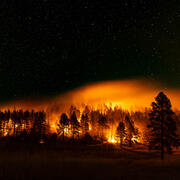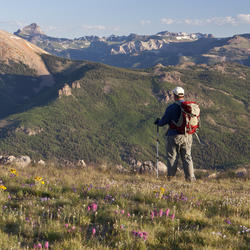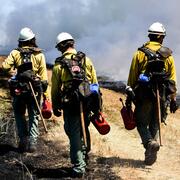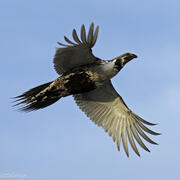Big sagebrush with rainbow at the SageSTEP project Five Creeks study site north of Steens Mountain in southeast Oregon. Photo by Steve Hanser (USGS).
Steven E Hanser
Since 2019, Steve has provided leadership at the Fort Collins Science Center as the Deputy Center Director. He has been acting as Center Director since April 2025.
Steve's work has focused on developing science, information, and tools in coordination with Department of the Interior, DOI bureaus, State wildlife agencies, and other partners. He has led or helped facilitate efforts to strengthen interagency coordination, identify multiagency research priorities, develop high-profile information syntheses, improve outreach and communication efforts, and enhance multiagency data sharing tools.
Professional Experience
Center Director (Acting), Fort Collins Science Center, U. S. Geological Survey, Ft. Collins, CO: April 2025 - Present
Deputy Center Director, Fort Collins Science Center, U. S. Geological Survey, Ft. Collins, CO: June 2019 - Present
Chief, Social and Economic Analysis Branch (Acting), U. S. Geological Survey, Ft. Collins, CO: December 2024 - Present
Chief, Invasive Species Science Branch, U. S. Geological Survey, Ft. Collins, CO: July 2022 - December 2024
Chief, Ecosystem and Landscape Dynamics Research Branch (Acting), U. S. Geological Survey, Ft. Collins, CO: July 2019 - January 2022
Chief, Decision Support Science and Tools Branch (Acting), U. S. Geological Survey, Ft. Collins, CO: April 2019 - June 2020
Sagebrush Ecosystem Program Specialist (Acting), U. S. Geological Survey, Reston, VA: June 2019 - Sept 2019
Sagebrush Ecosystem Program Specialist, U. S. Geological Survey, Reston, VA: January 2015 – June 2019
Wildland Fire Science Coordinator (Acting), U. S. Geological Survey, Reston, VA: July 2014 - Oct 2014
Wildlife Biologist, U.S. Geological Survey, Boise, ID: 2002-2015
Biological Science Technician, U.S. Geological Survey, Boise, ID: 2002
GIS Intern, City of Pocatello, Pocatello, ID: 2002
Graduate Research Assistant, Idaho State University, Pocatello, ID: 1999–2002
Research Technician, Iowa State University, Ames, IA: 1998-1999
Undergraduate Research Assistant, Iowa Cooperative Research Unit, Ames, IA: 1998-1999
Education and Certifications
M.S. Biology, Idaho State University, 2002
Geotechnologies Post-baccalaureate Certification, Idaho State University, 2002
B.S. Biology, Iowa State University, 1999
Science and Products
Greater Sage-Grouse Population Monitoring Framework
Ecosystem change science in support of wildfire management, water conservation, public land reclamation, and food security
Social and economic analysis research in support of public safety, outdoor recreation, and economic growth
Land management research in support of streamlined energy development, economic growth, and wildfire management
Fish and wildlife science in support of heritage preservation, efficient decision making, wild ungulate management, and outdoor recreation
Invasive species science in support of public safety, America’s natural resources, and economic growth
Greater Sage-Grouse Population Monitoring Framework: Cheat Sheet
Greater Sage-Grouse Population Monitoring Framework: Targeted Annual Warning System Information Sheet
Greater Sage-Grouse Population Monitoring Framework: Glossary of Terms
Greater Sage-Grouse Population Monitoring Framework: Frequently Asked Questions
Greater Sage-Grouse Population Monitoring Framework Data Inputs Information Sheet
Greater Sage-Grouse Population Monitoring Framework: Trends Analysis Information Sheet
Revised extents of neighborhood and climate population clusters for greater sage-grouse, western U.S. Revised extents of neighborhood and climate population clusters for greater sage-grouse, western U.S.
grsg_lekdb: Compiling and standardizing greater sage-grouse lek databases, version 1.2.0 grsg_lekdb: Compiling and standardizing greater sage-grouse lek databases, version 1.2.0
Proportion of Agricultural Land Cover (18-km scale) in the Wyoming Basins Ecoregional Assessment area Proportion of Agricultural Land Cover (18-km scale) in the Wyoming Basins Ecoregional Assessment area
Agricultural Land in the Western United States Agricultural Land in the Western United States
Trends and a Targeted Annual Warning System for Greater Sage-Grouse in the Western United States (ver. 4.0, November 2025) Trends and a Targeted Annual Warning System for Greater Sage-Grouse in the Western United States (ver. 4.0, November 2025)
Hierarchically nested and biologically relevant range-wide monitoring frameworks for greater sage-grouse, western United States Hierarchically nested and biologically relevant range-wide monitoring frameworks for greater sage-grouse, western United States
popcluster: hierarchical population monitoring frameworks, Version 2.0.0 popcluster: hierarchical population monitoring frameworks, Version 2.0.0
grsg_lekdb: Compiling and standardizing greater sage-grouse lek databases, version 1.1.0 grsg_lekdb: Compiling and standardizing greater sage-grouse lek databases, version 1.1.0
lcp_centrality: Defining least-cost paths and graph theory centrality measures lcp_centrality: Defining least-cost paths and graph theory centrality measures
Greater sage-grouse population structure and connectivity data to inform the development of hierarchical population units (western United States) Greater sage-grouse population structure and connectivity data to inform the development of hierarchical population units (western United States)
Agricultural Land Cover in the Wyoming Basins Ecoregional Assessment area Agricultural Land Cover in the Wyoming Basins Ecoregional Assessment area
grsg_lekdb: Compiling and standardizing greater sage-grouse lek databases grsg_lekdb: Compiling and standardizing greater sage-grouse lek databases
Big sagebrush with rainbow at the SageSTEP project Five Creeks study site north of Steens Mountain in southeast Oregon. Photo by Steve Hanser (USGS).
Cheatgrass on a frosty morning at the SageSTEP project Five Creeks study site north of Steens Mountain in southeast Oregon.
Cheatgrass on a frosty morning at the SageSTEP project Five Creeks study site north of Steens Mountain in southeast Oregon.

Pinyon-juniper and sagebrush on Juniper Mountain, NV
Pinyon-juniper and sagebrush on Juniper Mountain, NVPinyon-juniper and sagebrush on Juniper Mountain, Nevada.
Pinyon-juniper and sagebrush on Juniper Mountain, NV
Pinyon-juniper and sagebrush on Juniper Mountain, NVPinyon-juniper and sagebrush on Juniper Mountain, Nevada.
Sagebrush after juniper removal in Utah.
Big sagebrush landscape in southeast Oregon, Owyhee Uplands. Photo by Steve Hanser (USGS).
Big sagebrush landscape in southeast Oregon, Owyhee Uplands. Photo by Steve Hanser (USGS).
Range-wide population trend analysis for greater sage-grouse (Centrocercus urophasianus)—Updated 1960–2024 Range-wide population trend analysis for greater sage-grouse (Centrocercus urophasianus)—Updated 1960–2024
Range-wide population trend analysis for greater sage-grouse (Centrocercus urophasianus)—Updated 1960–2023 Range-wide population trend analysis for greater sage-grouse (Centrocercus urophasianus)—Updated 1960–2023
Evaluating spatial coverage of the greater sage-grouse umbrella to conserve sagebrush-dependent species biodiversity within the Wyoming basins Evaluating spatial coverage of the greater sage-grouse umbrella to conserve sagebrush-dependent species biodiversity within the Wyoming basins
Oil and gas reclamation—Operations, monitoring methods, and standards Oil and gas reclamation—Operations, monitoring methods, and standards
Integrated rangeland fire management strategy actionable science plan completion assessment— Climate and weather topic, 2015–20 Integrated rangeland fire management strategy actionable science plan completion assessment— Climate and weather topic, 2015–20
Range-wide population trend analysis for greater sage-grouse (Centrocercus urophasianus)—Updated 1960–2022 Range-wide population trend analysis for greater sage-grouse (Centrocercus urophasianus)—Updated 1960–2022
A targeted annual warning system developed for the conservation of a sagebrush indicator species A targeted annual warning system developed for the conservation of a sagebrush indicator species
Integrated rangeland fire management strategy actionable science plan completion assessment — Sagebrush and sage-grouse topic, 2015–20 Integrated rangeland fire management strategy actionable science plan completion assessment — Sagebrush and sage-grouse topic, 2015–20
Integrated rangeland fire management strategy actionable science plan completion assessment: Restoration topic, 2015–20 Integrated rangeland fire management strategy actionable science plan completion assessment: Restoration topic, 2015–20
Integrated rangeland fire management strategy actionable science plan completion assessment—Fire topic, 2015–20 Integrated rangeland fire management strategy actionable science plan completion assessment—Fire topic, 2015–20
Integrated rangeland fire management strategy actionable science plan completion assessment: Invasives topic, 2015–20 Integrated rangeland fire management strategy actionable science plan completion assessment: Invasives topic, 2015–20
Range-wide population trend analysis for greater sage-grouse (Centrocercus urophasianus)—Updated 1960–2021 Range-wide population trend analysis for greater sage-grouse (Centrocercus urophasianus)—Updated 1960–2021
Non-USGS Publications**
**Disclaimer: The views expressed in Non-USGS publications are those of the author and do not represent the views of the USGS, Department of the Interior, or the U.S. Government.
grsg_lekdb: Compiling and standardizing greater sage-grouse lek databases (version 1.3.0) grsg_lekdb: Compiling and standardizing greater sage-grouse lek databases (version 1.3.0)
grsg_lekdb: Compiling and standardizing greater sage-grouse lek databases, version 1.2.0 grsg_lekdb: Compiling and standardizing greater sage-grouse lek databases, version 1.2.0
popcluster: hierarchical population monitoring frameworks, Version 2.0.0 popcluster: hierarchical population monitoring frameworks, Version 2.0.0
grsg_lekdb: Compiling and standardizing greater sage-grouse lek databases, version 1.1.0 grsg_lekdb: Compiling and standardizing greater sage-grouse lek databases, version 1.1.0
lcp_centrality: Defining least-cost paths and graph theory centrality measures lcp_centrality: Defining least-cost paths and graph theory centrality measures
grsg_lekdb: Compiling and standardizing greater sage-grouse lek databases grsg_lekdb: Compiling and standardizing greater sage-grouse lek databases
popcluster: Developing Hierarchical Population Monitoring Frameworks for mobile species with high site fidelity popcluster: Developing Hierarchical Population Monitoring Frameworks for mobile species with high site fidelity
Science and Products
Greater Sage-Grouse Population Monitoring Framework
Ecosystem change science in support of wildfire management, water conservation, public land reclamation, and food security
Social and economic analysis research in support of public safety, outdoor recreation, and economic growth
Land management research in support of streamlined energy development, economic growth, and wildfire management
Fish and wildlife science in support of heritage preservation, efficient decision making, wild ungulate management, and outdoor recreation
Invasive species science in support of public safety, America’s natural resources, and economic growth
Greater Sage-Grouse Population Monitoring Framework: Cheat Sheet
Greater Sage-Grouse Population Monitoring Framework: Targeted Annual Warning System Information Sheet
Greater Sage-Grouse Population Monitoring Framework: Glossary of Terms
Greater Sage-Grouse Population Monitoring Framework: Frequently Asked Questions
Greater Sage-Grouse Population Monitoring Framework Data Inputs Information Sheet
Greater Sage-Grouse Population Monitoring Framework: Trends Analysis Information Sheet
Revised extents of neighborhood and climate population clusters for greater sage-grouse, western U.S. Revised extents of neighborhood and climate population clusters for greater sage-grouse, western U.S.
grsg_lekdb: Compiling and standardizing greater sage-grouse lek databases, version 1.2.0 grsg_lekdb: Compiling and standardizing greater sage-grouse lek databases, version 1.2.0
Proportion of Agricultural Land Cover (18-km scale) in the Wyoming Basins Ecoregional Assessment area Proportion of Agricultural Land Cover (18-km scale) in the Wyoming Basins Ecoregional Assessment area
Agricultural Land in the Western United States Agricultural Land in the Western United States
Trends and a Targeted Annual Warning System for Greater Sage-Grouse in the Western United States (ver. 4.0, November 2025) Trends and a Targeted Annual Warning System for Greater Sage-Grouse in the Western United States (ver. 4.0, November 2025)
Hierarchically nested and biologically relevant range-wide monitoring frameworks for greater sage-grouse, western United States Hierarchically nested and biologically relevant range-wide monitoring frameworks for greater sage-grouse, western United States
popcluster: hierarchical population monitoring frameworks, Version 2.0.0 popcluster: hierarchical population monitoring frameworks, Version 2.0.0
grsg_lekdb: Compiling and standardizing greater sage-grouse lek databases, version 1.1.0 grsg_lekdb: Compiling and standardizing greater sage-grouse lek databases, version 1.1.0
lcp_centrality: Defining least-cost paths and graph theory centrality measures lcp_centrality: Defining least-cost paths and graph theory centrality measures
Greater sage-grouse population structure and connectivity data to inform the development of hierarchical population units (western United States) Greater sage-grouse population structure and connectivity data to inform the development of hierarchical population units (western United States)
Agricultural Land Cover in the Wyoming Basins Ecoregional Assessment area Agricultural Land Cover in the Wyoming Basins Ecoregional Assessment area
grsg_lekdb: Compiling and standardizing greater sage-grouse lek databases grsg_lekdb: Compiling and standardizing greater sage-grouse lek databases
Big sagebrush with rainbow at the SageSTEP project Five Creeks study site north of Steens Mountain in southeast Oregon. Photo by Steve Hanser (USGS).
Big sagebrush with rainbow at the SageSTEP project Five Creeks study site north of Steens Mountain in southeast Oregon. Photo by Steve Hanser (USGS).
Cheatgrass on a frosty morning at the SageSTEP project Five Creeks study site north of Steens Mountain in southeast Oregon.
Cheatgrass on a frosty morning at the SageSTEP project Five Creeks study site north of Steens Mountain in southeast Oregon.

Pinyon-juniper and sagebrush on Juniper Mountain, NV
Pinyon-juniper and sagebrush on Juniper Mountain, NVPinyon-juniper and sagebrush on Juniper Mountain, Nevada.
Pinyon-juniper and sagebrush on Juniper Mountain, NV
Pinyon-juniper and sagebrush on Juniper Mountain, NVPinyon-juniper and sagebrush on Juniper Mountain, Nevada.
Sagebrush after juniper removal in Utah.
Big sagebrush landscape in southeast Oregon, Owyhee Uplands. Photo by Steve Hanser (USGS).
Big sagebrush landscape in southeast Oregon, Owyhee Uplands. Photo by Steve Hanser (USGS).
Range-wide population trend analysis for greater sage-grouse (Centrocercus urophasianus)—Updated 1960–2024 Range-wide population trend analysis for greater sage-grouse (Centrocercus urophasianus)—Updated 1960–2024
Range-wide population trend analysis for greater sage-grouse (Centrocercus urophasianus)—Updated 1960–2023 Range-wide population trend analysis for greater sage-grouse (Centrocercus urophasianus)—Updated 1960–2023
Evaluating spatial coverage of the greater sage-grouse umbrella to conserve sagebrush-dependent species biodiversity within the Wyoming basins Evaluating spatial coverage of the greater sage-grouse umbrella to conserve sagebrush-dependent species biodiversity within the Wyoming basins
Oil and gas reclamation—Operations, monitoring methods, and standards Oil and gas reclamation—Operations, monitoring methods, and standards
Integrated rangeland fire management strategy actionable science plan completion assessment— Climate and weather topic, 2015–20 Integrated rangeland fire management strategy actionable science plan completion assessment— Climate and weather topic, 2015–20
Range-wide population trend analysis for greater sage-grouse (Centrocercus urophasianus)—Updated 1960–2022 Range-wide population trend analysis for greater sage-grouse (Centrocercus urophasianus)—Updated 1960–2022
A targeted annual warning system developed for the conservation of a sagebrush indicator species A targeted annual warning system developed for the conservation of a sagebrush indicator species
Integrated rangeland fire management strategy actionable science plan completion assessment — Sagebrush and sage-grouse topic, 2015–20 Integrated rangeland fire management strategy actionable science plan completion assessment — Sagebrush and sage-grouse topic, 2015–20
Integrated rangeland fire management strategy actionable science plan completion assessment: Restoration topic, 2015–20 Integrated rangeland fire management strategy actionable science plan completion assessment: Restoration topic, 2015–20
Integrated rangeland fire management strategy actionable science plan completion assessment—Fire topic, 2015–20 Integrated rangeland fire management strategy actionable science plan completion assessment—Fire topic, 2015–20
Integrated rangeland fire management strategy actionable science plan completion assessment: Invasives topic, 2015–20 Integrated rangeland fire management strategy actionable science plan completion assessment: Invasives topic, 2015–20
Range-wide population trend analysis for greater sage-grouse (Centrocercus urophasianus)—Updated 1960–2021 Range-wide population trend analysis for greater sage-grouse (Centrocercus urophasianus)—Updated 1960–2021
Non-USGS Publications**
**Disclaimer: The views expressed in Non-USGS publications are those of the author and do not represent the views of the USGS, Department of the Interior, or the U.S. Government.

















